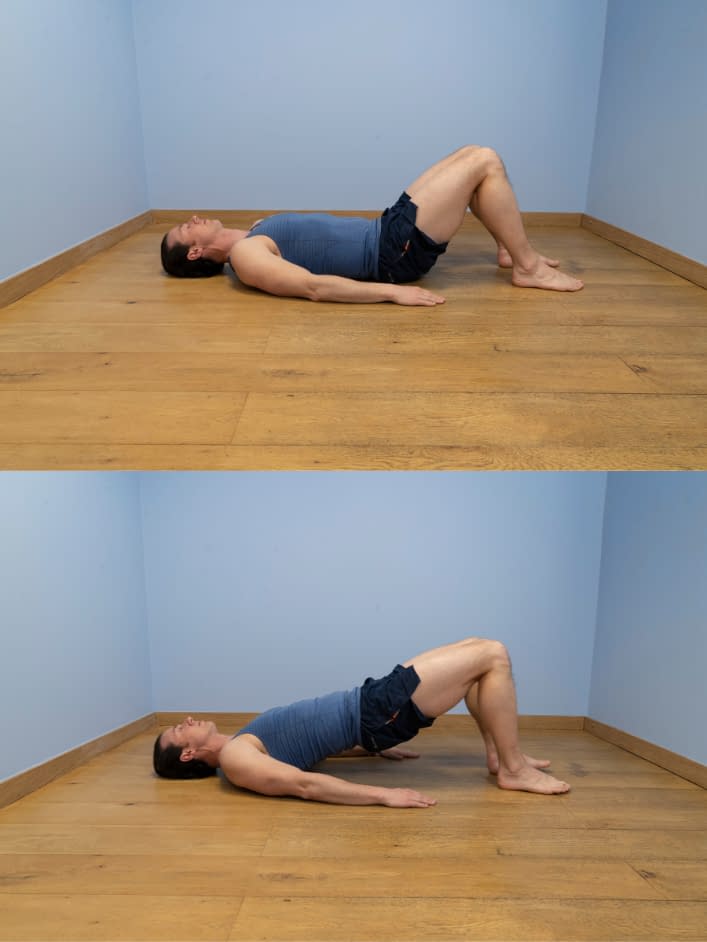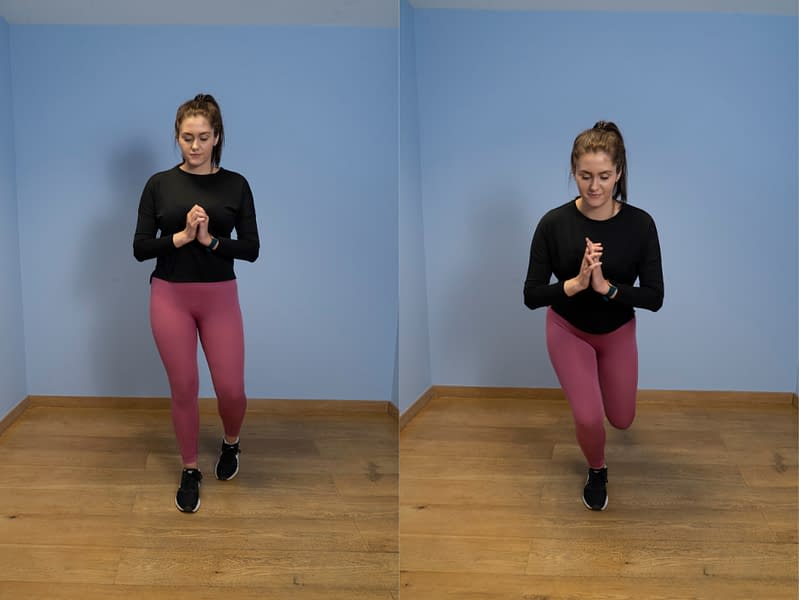Proximal Hamstring Tendinopathy Intermediate Exercise Programme
Aim to perform this programme a minimum of once per day unless prescribed otherwise. As with any new exercise, start slowly (repetitions as able) and build up as you are able within the guidelines below.
Pain should not exceed 5/10 whilst completing this exercise programme.
1. Step up
- Stand at the bottom of a step facing it – hold on to the wall/bannister if required for balance and/or support.
- Lift the affected leg and place the foot of the leading leg fully on the step.
- Straighten the leading leg by squeezing the thigh and buttock muscles as you rise up onto the step and bring the trailing leg up into standing.
- Reverse the movement carefully and with control, placing emphasis on using the standing leg.
2. Bridge in lying
- Lie on your back on the floor or bed with your knees bent at 90 degrees and your feet on the floor and your arms down by your side.
- Push your heels down into the floor to gently lift your hips upwards. Lift as high as you feel comfortable but no higher than a straight line between hips, knees and shoulders.
- If you feel discomfort, then try squeezing your tummy and bum muscles before starting the lift.
- Hold at the top for 5 seconds.
- Push up as far as you feel comfortable, and pain and stiffness allow.
3. Single leg squat with toe touch
- Start by standing with all the weight on one leg.
- Now place the other leg on the floor on the ball of the foot next to or slightly behind the standing leg.
- Begin with 60% of the weight on the standing leg and 40% on the supporting leg.
- Bend the knee and at the same time bend the hip as if you were sitting back into a chair.
- Go down until the standing knee is approximately at a right angle.
- Slowly return to an upright position and repeat.
We recommend consulting a musculoskeletal physiotherapist to ensure exercises are best suited to your recovery. If you are carrying out an exercise regime without consulting a healthcare professional, you do so at your own risk. If you have any concerns whilst completing these exercises, please contact a healthcare professional.
More Plans
This initial programme focuses on early, appropriate loading of the affected tendon and maintenance of lower limb strength and stability. Some of these simple strengthening exercises can be performed little and often during the day to help relieve pain and begin to strengthen your tendon. Isometric exercises (where the muscles contract against a fixed resistance without a change in the position of your leg) are an effective way to load the tendon and reduce pain in the early stages of this condition. This should not exceed any more than 5/10 on your perceived pain scale.
- 0
- 1
- 2
- 3
- 4
- 5
- 6
- 7
- 8
- 910
The goal of the advanced rehabilitation plan is to continue to build further hamstring strength but in positions that place greater functional strain on the hamstring. The exercises you complete here are similar to the intermediate programme, but aim to challenge your hamstring muscles through a larger range of movement, with more repetitions or increased amounts of resistance. Single leg exercises are important to address any differences in strength between your painful and non-painful side. Exercises that encourage your muscles to work for faster, shorter spells of exercise (sometimes known as plyometrics) can help prepare you for a return to sport or running. This should not exceed any more than 5/10 on your perceived pain scale.
- 0
- 1
- 2
- 3
- 4
- 5
- 6
- 7
- 8
- 910


